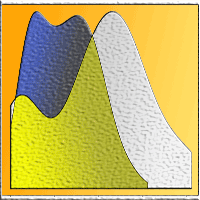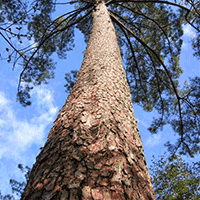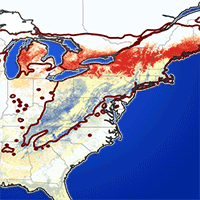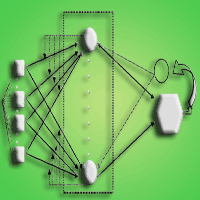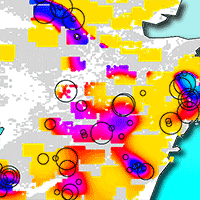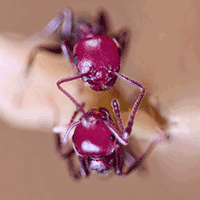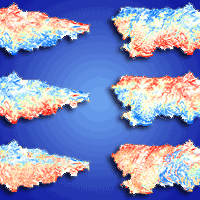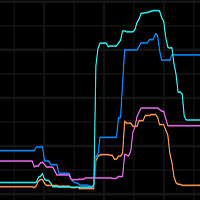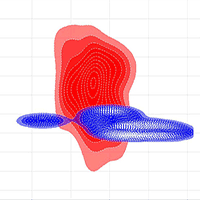Quantification of niche overlap represents an important topic in several aspects of ecology and conservation biology, although it could be potentially affected by imperfect detection, i.e., failure to detect a species at occupied sites. We investigate the effect of imperfect detection on niche overlap quantification in two arboreal rodents, the edible dormouse (Glis glis) and the hazel dormouse (Muscardinus avellanarius). For both species, we used Generalized Linear Mixed Models (GLMM) to estimate the occurrence probability and Occupancy Models (OM) to calculate occurrence and detection probabilities. By comparing these predictions through niche equivalency and similarity tests, we first hypothesised that methods correcting for imperfect detection (OM) provide a more reliable estimate of niche overlap than traditional presence/ absence methods (GLMM). Furthermore, we hypothesised that GLMM mainly estimate species detectability rather than actual occurrence, and that a low number of sampling replicates provokes an underestimation of species niche by GLMM. Our results highlighted that GLMM-based niche overlap yielded significant outcomes only for the equivalency test, while OM-based niche overlap reported significant outcomes for both niche equivalency and similarity tests. Moreover, GLMM occurrence probabilities and OM detectabilities were not statistically different. Lastly, GLMM predictions based on single sampling replicates were statistically different from the average occurrence probability predicted by GLMM over all replicates. We emphasized how accounting for imperfect detection can improve the statistical significance and interpretability of niche overlap estimates based on occurrence data. Under a habitat management perspective, an accurate quantification of niche overlap may provide useful information to assess the effects of different management practices on species occurrence.
Keywords
, , ,
Citation
Paniccia C, Di Febbraro M, Frate L, Sallustio L, Santopuoli G, Altea T, Posillico M, Marchetti M, Loy A (2018). Effect of imperfect detection on the estimation of niche overlap between two forest dormice. iForest 11: 482-490. - doi: 10.3832/ifor2738-011
Academic Editor
Massimo Faccoli
Paper history
Received: Jan 24, 2018
Accepted: May 01, 2018
First online: Jul 18, 2018
Publication Date: Aug 31, 2018
Publication Time: 2.60 months
© SISEF - The Italian Society of Silviculture and Forest Ecology 2018
Open Access
This article is distributed under the terms of the Creative Commons Attribution-Non Commercial 4.0 International (https://creativecommons.org/licenses/by-nc/4.0/), which permits unrestricted use, distribution, and reproduction in any medium, provided you give appropriate credit to the original author(s) and the source, provide a link to the Creative Commons license, and indicate if changes were made.

Breakdown by View Type
(Waiting for server response...)
Article Usage
Total Article Views: 49942
(from publication date up to now)
Breakdown by View Type
HTML Page Views: 42016
Abstract Page Views: 3526
PDF Downloads: 3440
Citation/Reference Downloads: 8
XML Downloads: 952
Web Metrics
Days since publication: 2707
Overall contacts: 49942
Avg. contacts per week: 129.14
Article Citations
Article citations are based on data periodically collected from the Clarivate Web of Science web site
(last update: Mar 2025)
Total number of cites (since 2018): 8
Average cites per year: 1.00
Publication Metrics
by Dimensions ©
Articles citing this article
List of the papers citing this article based on CrossRef Cited-by.
(1)
Amori G, Contoli L, Nappi A (2008)Fauna d’Italia. Mammalia II. Erinaceomorpha, Soricomorpha, Lagomorpha, Rodentia [Fauna of Italy. Mammalia II. Erinaceomorpha, Soricomorpha, Lagomorpha, Rodentia]. Edizioni Calderini - Il Sole 24 ORE, Edagricole, Bologna, Italy, pp. 736. [in Italian]
Gscholar
(2)
Araya YN, Silvertown J, Gowing DJ, McConway KJ, Peter Linder H, Midgley G (2011)A fundamental, eco-hydrological basis for niche segregation in plant communities. New Phytologist 189: 253-258.
CrossRef |
Gscholar
(3)
Bailey LL, Mackenzie DI, Nichols JD (2014)Advances and applications of occupancy models. Methods in Ecology and Evolution 5: 1269-1279.
CrossRef |
Gscholar
(4)
Barton K (2018)MuMIn: multi-model inference (version 1.40.4). Web site.
Online |
Gscholar
(5)
Bates D, Mächler M, Bolker BM, Walker SC (2015)Fitting linear mixed-effects models using lme4. Journal of Statistical Software 67: 1-48.
CrossRef |
Gscholar
(6)
Bieber C, Ruf T (2009)Habitat differences affect life history tactics of a pulsed resource consumer, the edible dormouse (
Glis glis). Population Ecology 51: 481-492.
CrossRef |
Gscholar
(7)
Blasi C, Fortini P, Grossi G, Presti G (2005)Faggete e cerrete mesofile nell’Alto Molise [Beech and mesophilous Quercus cerris woodlands in Alto Molise (central Italy)]. Fitosociologia 42: 67-81. [in Italian]
Online |
Gscholar
(8)
Bright PW, Morris PA (1991)Ranging and nesting behaviour of the dormouse,
Muscardinus avellanarius, in diverse low-growing woodland. Journal of Zoology 224: 177-190.
CrossRef |
Gscholar
(9)
Bright PW, Morris PA (1992)Ranging and nesting behaviour of the dormouse
Muscardinus avellanarius, in coppice-with-standards woodland. Journal of Zoology 226: 589-600.
CrossRef |
Gscholar
(10)
Bright PW, Mitchell P, Morris PA (1994)Dormouse distribution: survey techniques, insular ecology and selection of sites for conservation. Journal of Applied Ecology 31: 329-339.
CrossRef |
Gscholar
(11)
Broennimann O, Fitzpatrick MC, Pearman PB, Petitpierre B, Pellissier L, Yoccoz NG, Thuiller W, Fortin MJ, Randin C, Zimmermann NE, Graham CH, Guisan A (2012)Measuring ecological niche overlap from occurrence and spatial environmental data. Global Ecology and Biogeography 21: 481-497.
CrossRef |
Gscholar
(12)
Broennimann O, Di Cola V, Petitpierre B, Breiner F, D’Amen M, Randin C, Engler R, Hordijk W, Pottier J, Di Febbraro M, Pellissier L, Pio D, Mateo RG, Dubuis A, Scherrer D, Maiorano L, Psomas A, Ndiribe C, Salamin N, Zimmermann N, Guisan A (2017)“ecospat”: spatial ecology miscellaneous methods (version 2.2.0). Web site.
Online |
Gscholar
(13)
Burnham KP, Anderson DR (2002)Model selection and multimodel inference: a practical information - theoretic approach (2nd edn). Springer-Verlag, New York, USA, pp. 488.
CrossRef |
Gscholar
(14)
Burnham KP, Anderson DR, Huyvaert KP (2011)AIC model selection and multimodel inference in behavioral ecology: some background, observations, and comparisons. Behavioral Ecology and Sociobiology 65: 23-35.
CrossRef |
Gscholar
(15)
Capizzi D, Battistini M, Amori G (2002)Analysis of the hazel dormouse,
Muscardinus avellanarius, distribution in a Mediterranean fragmented woodland. Italian Journal of Zoology 69: 25-31.
CrossRef |
Gscholar
(16)
Capizzi D, Battistini M, Amori G (2003)Effects of habitat fragmentation and forest management on the distribution of the edible dormouse
Glis glis. Acta Theriologica 48: 359-371.
CrossRef |
Gscholar
(17)
Chen G, Kéry M, Plattner M, Ma K, Gardner B (2013)Imperfect detection is the rule rather than the exception in plant distribution studies. Journal of Ecology 101: 183-191.
CrossRef |
Gscholar
(18)
Chiavetta U, Sallustio L, Garfì V, Maesano M, Marchetti M (2012)Classification of the oldgrowthness of forest inventory plots with dissimilarity metrics in Italian National Parks. European Journal of Forest Research 131: 1473-1483.
CrossRef |
Gscholar
(19)
Ciancio O, Corona P, Lamonaca A, Portoghesi L, Travaglini D (2006)Conversion of clearcut beech coppices into high forests with continuous cover: a case study in central Italy. Forest Ecology and Management 224: 235-240.
CrossRef |
Gscholar
(20)
Cornils JS, Hoelzl F, Rotter B, Bieber C, Ruf T (2017)Edible dormice (
Glis glis) avoid areas with a high density of their preferred food plant - the European beech. Frontiers in Zoology 14: 1-10.
CrossRef |
Gscholar
(21)
Fiske IJ, Chandler RB (2011)“unmarked”: an R package for fitting hierarchical models of wildlife occurrence and abundance. Journal of Statistical Software 43: 1-23.
CrossRef |
Gscholar
(22)
Frate L, Carranza ML, Garfì V, Di Febbraro M, Tonti D, Marchetti M, Ottaviano M, Santopuoli G, Chirici G (2016)Spatially explicit estimation of forest age by integrating remotely sensed data and inverse yield modeling techniques. iForest 9: 63-71.
CrossRef |
Gscholar
(23)
Gasparini P, Tabacchi G (2011)L’Inventario Nazionale delle Foreste e dei serbatoi forestali di Carbonio INFC 2005. Secondo inventario forestale nazionale italiano. Metodi e risultati [National inventory of forests and forest carbon sinks INFC 2005. Second Italian national forest inventory. Methods and results]. Ministero delle Politiche Agricole, Alimentari e Forestali, Corpo Forestale dello Stato, Consiglio per la Ricerca e la Sperimentazione in Agricoltura, Unità di ricerca per il Monitoraggio e la Pianificazione Forestale, Edagricole, Bologna, Italy, pp. 1-653. [in Italian]
Gscholar
(24)
Green AW, Bailey LL, Nichols JD (2011)Exploring sensitivity of a multistate occupancy model to inform management decisions. Journal of Applied Ecology 48: 1007-1016.
CrossRef |
Gscholar
(25)
Gregory SD, MacDonald DW (2009)Prickly coexistence or blunt competition?
Opuntia refugia in an invaded rodent community. Oecologia 159: 225-236.
CrossRef |
Gscholar
(26)
Grinnell J (1917)The niche-relationships of the California Thrasher. The Auk 34: 427-433.
CrossRef |
Gscholar
(27)
Guillera-Arroita G (2017)Modelling of species distributions, range dynamics and communities under imperfect detection: advances, challenges and opportunities. Ecography 40: 281-295.
CrossRef |
Gscholar
(28)
Guisan A, Petitpierre B, Broennimann O, Daehler C, Kueffer C (2014)Unifying niche shift studies: insights from biological invasions. Trends in Ecology and Evolution 29: 260-269.
CrossRef |
Gscholar
(29)
Hutchinson GE (1957)Concluding remarks. Cold Spring Harbor Symposia on Quantitative Biology 22: 415-427.
CrossRef |
Gscholar
(30)
Johnson PCD, Barry SJE, Ferguson HM, Müller P, Schielzeth H (2015)Power analysis for generalized linear mixed models in ecology and evolution. Methods in Ecology and Evolution 6: 133-142.
CrossRef |
Gscholar
(31)
Juškaitis R, Siozinyte V (2008)Habitat requirements of the common dormouse (
Muscardinus avellanarius) and the fat dormouse (
Glis glis) in mature mixed forest in Lithuania. Ekológia 27: 143-151.
Online |
Gscholar
(32)
Kirchheimer B, Schinkel CFF, Dellinger AS, Klatt S, Moser D, Winkler M, Lenoir J, Caccianiga M, Guisan A, Nieto-Lugilde D, Svenning JC, Thuiller W, Vittoz P, Willner W, Zimmermann NE, Hörandl E, Dullinger S (2016)A matter of scale: apparent niche differentiation of diploid and tetraploid plants may depend on extent and grain of analysis. Journal of Biogeography 43: 716-726.
CrossRef |
Gscholar
(33)
Lahoz-Monfort JJ, Guillera-Arroita G, Wintle BA (2014)Imperfect detection impacts the performance of species distribution models. Global Ecology and Biogeography 23: 504-515.
CrossRef |
Gscholar
(34)
Lombardi F, Lasserre B, Tognetti R, Marchetti M (2008)Deadwood in relation to stand management and forest type in Central Apennines (Molise, Italy). Ecosystems 11: 882-894.
CrossRef |
Gscholar
(35)
MacKenzie DI, Nichols JD, Lachman GB, Droege S, Royle JA, Langtimm CA (2002)Estimating site occupancy rates when detection probabilities are less than one. Ecology 83: 2248-2255.
CrossRef |
Gscholar
(36)
Mackenzie DI, Royle JA (2005)Designing occupancy studies: general advice and allocating survey effort. Journal of Applied Ecology 42: 1105-1114.
CrossRef |
Gscholar
(37)
McCullagh P, Nelder JA (1989)Generalized Linear Models. CRC Monographs on Statistics and Applied Probability, Chapman and Hall London, New York, USA pp. 532.
CrossRef |
Gscholar
(38)
McGill BJ, Etienne RS, Gray JS, Alonso D, Anderson MJ, Benecha HK, Dornelas M, Enquist BJ, Green JL, He F, Hurlbert AH, Magurran AE, Marquet PA, Maurer BA, Ostling A, Soykan CU, Ugland KI, White EP (2007)Species abundance distributions: moving beyond single prediction theories to integration within an ecological framework. Ecology Letters 10: 995-1015.
CrossRef |
Gscholar
(39)
Mortelliti A, Santulli Sanzo G, Boitani L (2009)Species’ surrogacy for conservation planning: caveats from comparing the response of three arboreal rodents to habitat loss and fragmentation. Biodiversity and Conservation 18: 1131-1145.
CrossRef |
Gscholar
(40)
Mortelliti A, Crane M, Okada S, Lindenmayer DB (2015)Marsupial response to matrix conversion: results of a large-scale long-term “natural experiment” in Australia. Biological Conservation 191: 60-66.
CrossRef |
Gscholar
(41)
Nagelkerke NJD (1991)A note on a general definition of the coefficient of determination. Biometrika 78: 691-692.
CrossRef |
Gscholar
(42)
Nakagawa S, Freckleton RP (2011)Model averaging, missing data and multiple imputation: a case study for behavioural ecology. Behavioral Ecology and Sociobiology 65: 103-116.
CrossRef |
Gscholar
(43)
Nakagawa S, Schielzeth H, Hara RB (2013)A general and simple method for obtaining R
2 from generalized linear mixed-effects models. Methods in Ecology and Evolution 4: 133-142.
CrossRef |
Gscholar
(44)
Panchetti F, Sorace A, Amori G, Carpaneto GM (2007)Nest site preference of common dormouse (
Muscardinus avellanarius) in two different habitat types of Central Italy. Italian Journal of Zoology 74: 363-369.
CrossRef |
Gscholar
(45)
R Development Core Team (2018)R: a language and environment for statistical computing. R Foundation for Statistical Computing, Vienna, Austria.
Online |
Gscholar
(46)
Raes N (2012)Partial
versus full species distribution models. Natureza and Conservação 10: 127-138.
CrossRef |
Gscholar
(47)
Rota CT, Fletcher RJ, Evans JM, Hutto RL (2011)Does accounting for imperfect detection improve species distribution models? Ecography 34: 659-670.
CrossRef |
Gscholar
(48)
Russo D, Di Febbraro M, Cistrone L, Jones G, Smeraldo S, Garonna AP, Bosso L (2015)Protecting one, protecting both? Scale-dependent ecological differences in two species using dead trees, the rosalia longicorn beetle and the barbastelle bat. Journal of Zoology 297: 165-175.
CrossRef |
Gscholar
(49)
Schoener TW (1970)Nonsynchronous spatial overlap of lizards in patchy habitats. Ecology 51: 408-418.
CrossRef |
Gscholar
(50)
Scolastri A, Cancellieri L, Iocchi M, Cutini M (2017)Old coppice versus high forest: the impact of beech forest management on plant species diversity in central Apennines (Italy). Journal of Plant Ecology 10: 271-280.
CrossRef |
Gscholar
(51)
Sozio G, Iannarilli F, Melcore I, Boschetti M, Fipaldini D, Luciani M, Roviani D, Schiavano A, Mortelliti A (2016)Forest management affects individual and population parameters of the hazel dormouse
Muscardinus avellanarius. Mammalian Biology 81: 96-103.
CrossRef |
Gscholar
(52)
Vizzarri M, Chiavetta U, Chirici G, Garfì V, Bastrup-Birk A, Marchetti M (2015)Comparing multisource harmonized forest types mapping: a case study from central Italy. iForest 8: 59-66.
CrossRef |
Gscholar
(53)
Warren DL, Glor RE, Turelli M (2008)Environmental niche equivalency versus conservatism: quantitative approaches to niche evolution. Evolution 62: 2868-2883.
CrossRef |
Gscholar
(54)
Zuur AF, Ieno EN, Elphick CS (2010)A protocol for data exploration to avoid common statistical problems. Methods in Ecology and Evolution 1: 3-14.
CrossRef |
Gscholar
(55)
Zuur AF, Hilbe JM, Ieno EN (2013)A beginner’s guide to GLM and GLMM with R: frequentist and Bayesian perspective for ecologists. Highland Statistics Limited, Newburgh, USA, pp. 253.
Gscholar
